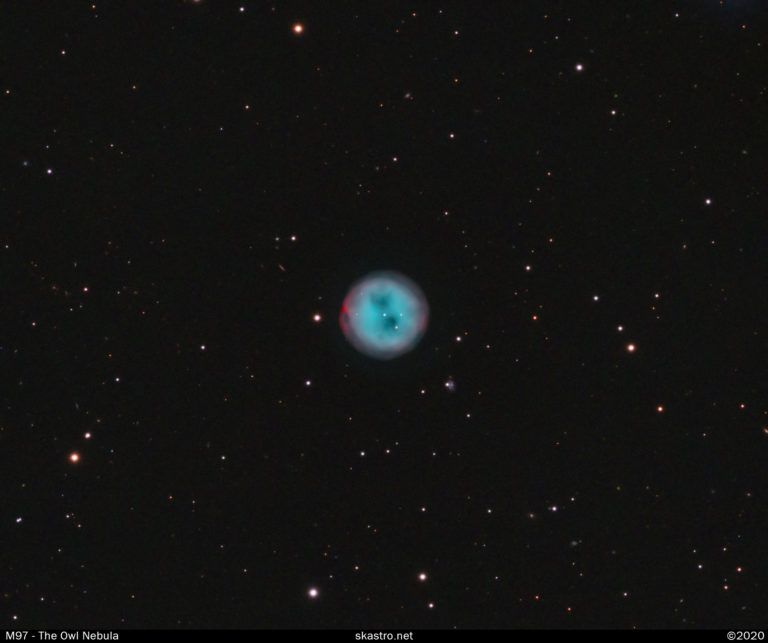The Horsehead Nebula in HaRGB A famous, indeed iconic nebula in the constellation Orion, The Horsehead was not even discovered until 1888 with the advent of astro photography. It is very faint to see visually with a telescope. The image above was captured with my TEC 140 refractor and Atik 460 CCD camera with Astrodon RGB and Ha(3nm) filters. It contains a total of 120 minutes of Ha data and 45 minutes each of RGB data, everything binned 1×1 with 5 minutes exposures.
The Owl Nebula The Owl Nebula is a planetary nebula in the constellation of Ursa Major, one of three planetary nebulae in the Messier catalogue. It is visible as a faint smudge in amateur telescopes but the colours are not evident visually. It is called The Owl Nebula because of the resemblance to the face of an owl. 6 hours and 30 minutes of LRGB in this image M97 Annotated Version The annotated version above shows many distant galaxies in the same field of view as M97, although obviously these are very much more distant. Annotated Version HOO Version The HOO version above shows the Owl Nebula with Hydrogen Alpha mapped as Red channel and OIII mapped to Green and Blue to create the HOO palette colours. 3 hours and 30 minutes of HaOIII. This HOO image could really do with more data added to it in the Ha and…
Located in the constellation of Coma Berenices, The Needle Galaxy is an almost edge on galaxy about 40 million light years away. Much detail can be seen in the dusty lanes of the edge-on spiral arms. This picture is a two year project, off and on. I acquired the luminance data in May 2019 with a view to completing the image then. However, cloudy weather then plagued the UK for weeks, and when it eventually cleared the object had vanished behind neighbouring roofs! So I had to park this image and wait a year to collect the RGB colour data in April 2020 (whilst my country [UK] was in lockdown due to the coronavirus). NGC4565 – The Needle Galaxy Data used to build the image collected with TEC140 refractor and Atik460 CCD camera with Astrodon LRGB Gen 2 E-series filters. I used Off-Axis guiding on my Mesu 200 mount. Data…
M81 in Ursa Major M81 is a face on spiral galaxy in the constellation of Ursa Major and it (and nearby M82) are the most northerly of the Messier objects. It is easily visible in binoculars as a faint smudge. Its open spiral arms and red HII star forming regions make it a popular target for amateur and professional astronomers alike. In this picture note at the four o’clock position the very faint satellite galaxy Holmberg II. It is located about 12 million light years away, placing it outside of the local group and it is steadily receding from us. I have imaged M81 in several settings. This picture was taken with my TEC140 refractor and Atik 460 CCD camera with Baader LRGBHa filters. It contains five hours of luminance of 900s exposure, two hours of Ha data and 90 minutes in each of RGB to give a total integration…
M13 is arguably the greatest of the Northern hemisphere globular clusters and, after Omega Centauri, the greatest globular cluster in the sky. It is a located about 26000 light years away and has a diameter of about 120 light years. It is one of about 250 globular clusters that surround the nucleus of our galaxy. Most galaxies have globular clusters in orbit around them and the reason why is still unclear. What is clear is that the clusters and the stars within them are extremely old, in the region of ten billion years old or twice the age of the sun. M13 is visible with the naked eye on a dark night as a fuzzy star. A telescope reveals its starry nature and a scope over 8 inches will show many stars and is an amazing site to behold. M13 – The Great Globular Cluster in Hercules The above image…





